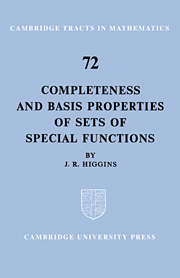Book contents
Summary
The sets of functions which form the subject matter of this book are to be considered as sequences in metric spaces. Actually we shall be almost exclusively concerned with various Lp spaces, particularly the case p = 2, and with subspaces of such spaces. Although the notes which follow in §1.1 and §1.2 contain sufficient metric space theory for an understanding of the rest of the book, the reader who is new to metric spaces may wish to fill in from a good text such as Copson (1967). For general background reading Simmons (1963) is also highly recommended.
Throughout the book an effort has been made to present theorems which are sufficiently general to be ‘useful’, but in a small introductory book of this kind a great deal of detail has to be left out; adequate references are given for those who want to consult more advanced sources.
1.1 Notes on metric spaces
1.1.1 Vector space It is assumed that the reader is familiar with elementary set theory. The word ‘space’ is used in mathematics to mean a set with some internal ‘structure’. Let V be a set whose elements are to be called vectors, and let F be a field (the field of scalars; we will usually take it to be the field of complex numbers). The basic structure that we shall require for V is that it be closed under an operation of addition of two vectors u and v, denoted by u + v, and an operation of multiplication of a vector u by a scalar f of F, denoted by fu.
Information
- Type
- Chapter
- Information
- Publisher: Cambridge University PressPrint publication year: 1977
